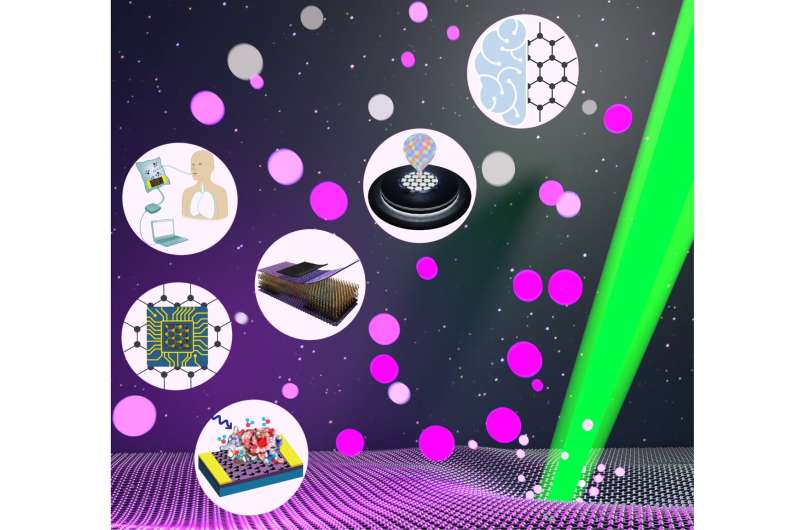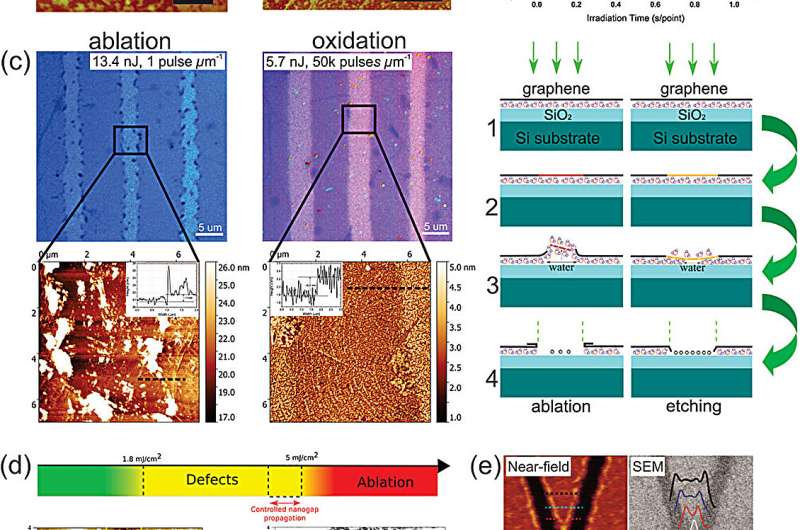This article has been reviewed according to Science X's editorial process and policies. Editors have highlighted the following attributes while ensuring the content's credibility:
fact-checked
peer-reviewed publication
trusted source
proofread
Study highlights potential of ultrafast laser processing for next-gen devices

A new joint study uncovers the remarkable potential of ultrafast lasers that could provide innovative solutions in 2D materials processing for many technology developers such as high-speed photodetectors, flexible electronics, biohybrids, and next-generation solar cells.
The manipulation of 2D materials, such as graphene and transition metal dichalcogenides (TMDs), is crucial for the advancement of next-generation electronic, photonic, quantum, and sensor technologies. These materials exhibit unique properties, including high electrical conductivity, mechanical flexibility, and tunable optical characteristics.
Traditional processing methods, however, often lack the necessary precision and can introduce thermal damage. This is where ultrafast laser processing comes into play, offering unprecedented control over the material properties at the nanoscale.
Ultrafast lasers for modifying materials
Recent advancements in the field of light-matter interactions have paved the way for the transformative use of ultrafast laser processing in 2D materials. A new study by Aleksei Emelianov, Mika Pettersson from the University of Jyväskylä (Finland), and Ivan Bobrinetskiy from Biosense Institute (Serbia) explores the remarkable potential of ultrafast laser techniques in manipulating 2D layered materials and van der Waals (vdW) heterostructures toward novel applications.
"Ultrafast laser processing has emerged as a versatile technique for modifying materials and introducing novel functionalities. Unlike continuous-wave and long-pulsed optical methods, ultrafast lasers offer a solution for thermal heating issues. The nonlinear interactions between ultrafast laser pulses and the atomic lattice of 2D materials substantially influence their chemical and physical properties," says Postdoctoral Researcher Emelianov from University of Jyväskylä.

A new tool for manipulating the properties of 2D materials
The researchers describe progress made over the past decade and primarily focus on the transformative role of ultrafast laser pulses in maskless green technology, enabling subtractive and additive processes that unveil ways for advanced devices. Utilizing the synergetic effect between the energy states within the atomic layers and ultrafast laser irradiation, it is feasible to achieve resolution down to several nanometers.
"Ultrafast light-matter interactions are being actively probed to study the unique optical properties of low-dimensional materials," says Emelianov. "In our research, we discovered that ultrafast laser processing has the potential to become a new technological tool for manipulating the properties of 2D materials," he continues.
Reliable tools for advanced materials processing
Key advancements are discussed in functionalization, doping, atomic reconstruction, phase transformation, and 2D and 3D micro- and nanopatterning. The ability to manipulate 2D materials at such a fine scale opens up numerous possibilities for the development of novel photonic, electronic, and sensor applications.
Potential applications include high-speed photodetectors, flexible electronics, biohybrids, and next-generation solar cells. The precision of ultrafast laser processing enables the creation of intricate micro- and nanoscale structures with potential utilization in telecommunications, medical diagnostics, and environmental monitoring.
"It is surprising how versatile ultrafast lasers are in tuning and modifying 2D materials. It is highly likely that lasers could provide innovative solutions in 2D materials processing for many technology developers," adds Pettersson.
This review represents a significant step forward in realizing the full potential of 2D and vdW materials, promising to drive new advancements in technology and industry.
"Still, there is a need for research on the physical basics of ultrafast interactions between lasers and 2D materials," says Bobrinetskiy. "These should include not only interactions between the 2D material lattice and light but also involve the environment and substrates, which makes the physics of these processes more complicated but exciting at the same time."
More information: Aleksei V. Emelianov et al, Ultrafast Laser Processing of 2D Materials: Novel Routes to Advanced Devices, Advanced Materials (2024). DOI: 10.1002/adma.202402907
Journal information: Advanced Materials
Provided by University of Jyväskylä



















